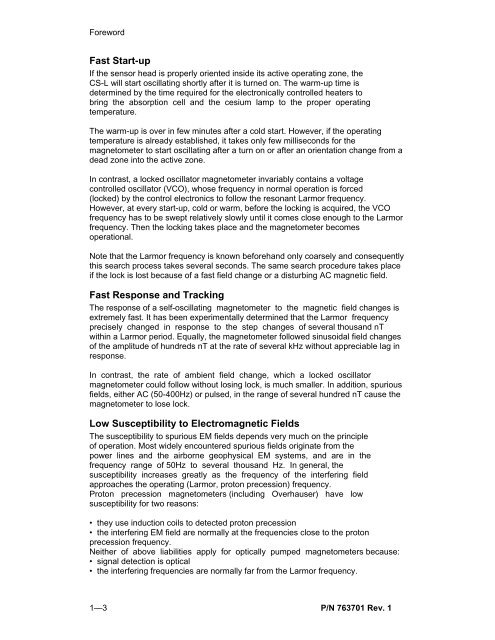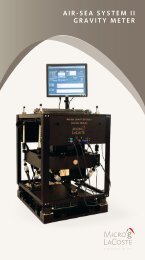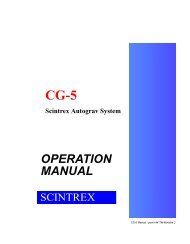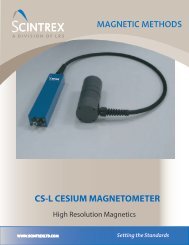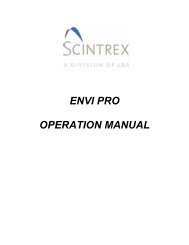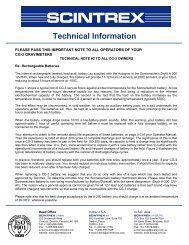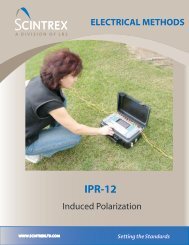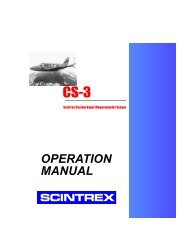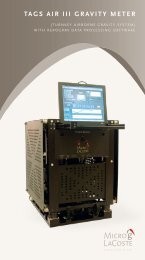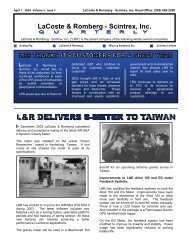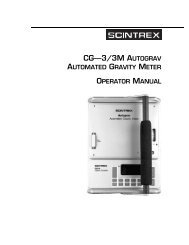CS-L Cesium Vapor Magnetometer Sensor OPERATION ... - Scintrex
CS-L Cesium Vapor Magnetometer Sensor OPERATION ... - Scintrex
CS-L Cesium Vapor Magnetometer Sensor OPERATION ... - Scintrex
You also want an ePaper? Increase the reach of your titles
YUMPU automatically turns print PDFs into web optimized ePapers that Google loves.
Foreword<br />
Fast Start-up<br />
If the sensor head is properly oriented inside its active operating zone, the<br />
<strong>CS</strong>-L will start oscillating shortly after it is turned on. The warm-up time is<br />
determined by the time required for the electronically controlled heaters to<br />
bring the absorption cell and the cesium lamp to the proper operating<br />
temperature.<br />
The warm-up is over in few minutes after a cold start. However, if the operating<br />
temperature is already established, it takes only few milliseconds for the<br />
magnetometer to start oscillating after a turn on or after an orientation change from a<br />
dead zone into the active zone.<br />
In contrast, a locked oscillator magnetometer invariably contains a voltage<br />
controlled oscillator (VCO), whose frequency in normal operation is forced<br />
(locked) by the control electronics to follow the resonant Larmor frequency.<br />
However, at every start-up, cold or warm, before the locking is acquired, the VCO<br />
frequency has to be swept relatively slowly until it comes close enough to the Larmor<br />
frequency. Then the locking takes place and the magnetometer becomes<br />
operational.<br />
Note that the Larmor frequency is known beforehand only coarsely and consequently<br />
this search process takes several seconds. The same search procedure takes place<br />
if the lock is lost because of a fast field change or a disturbing AC magnetic field.<br />
Fast Response and Tracking<br />
The response of a self-oscillating magnetometer to the magnetic field changes is<br />
extremely fast. It has been experimentally determined that the Larmor frequency<br />
precisely changed in response to the step changes of several thousand nT<br />
within a Larmor period. Equally, the magnetometer followed sinusoidal field changes<br />
of the amplitude of hundreds nT at the rate of several kHz without appreciable lag in<br />
response.<br />
In contrast, the rate of ambient field change, which a locked oscillator<br />
magnetometer could follow without losing lock, is much smaller. In addition, spurious<br />
fields, either AC (50-400Hz) or pulsed, in the range of several hundred nT cause the<br />
magnetometer to lose lock.<br />
Low Susceptibility to Electromagnetic Fields<br />
The susceptibility to spurious EM fields depends very much on the principle<br />
of operation. Most widely encountered spurious fields originate from the<br />
power lines and the airborne geophysical EM systems, and are in the<br />
frequency range of 50Hz to several thousand Hz. In general, the<br />
susceptibility increases greatly as the frequency of the interfering field<br />
approaches the operating (Larmor, proton precession) frequency.<br />
Proton precession magnetometers (including Overhauser) have low<br />
susceptibility for two reasons:<br />
• they use induction coils to detected proton precession<br />
• the interfering EM field are normally at the frequencies close to the proton<br />
precession frequency.<br />
Neither of above liabilities apply for optically pumped magnetometers because:<br />
• signal detection is optical<br />
• the interfering frequencies are normally far from the Larmor frequency.<br />
1—3<br />
P/N 763701 Rev. 1


